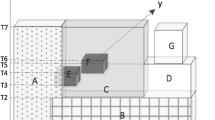Abstract
Topological relations have played important roles in spatial query, analysis and reasoning. In a two-dimensional space (IR2), most existing topological models can distinguish the eight basic topological relations between two spatial regions. Due to the arbitrariness and complexity of topological relations between spatial regions, it is difficult for these models to describe the order property of transformations among the topological relations, which is important for detailed analysis of spatial relations. In order to overcome the insufficiency in existing models, a multi-level modeling approach is employed to describe all the necessary details of region–region relations based upon topological invariants. In this approach, a set of hierarchically topological invariants is defined based upon the boundary–boundary intersection set (BBIS) of two involved regions. These topological invariants are classified into three levels based upon spatial set concept proposed, which include content, dimension and separation number at the set level, the element type at the element level, and the sequence at the integrated level. Corresponding to these hierarchical invariants, multi-level formal models of topological relations between spatial regions are built. A practical example is provided to illustrate the use of the approach presented in this paper.
















Similar content being viewed by others
References
R.F. Abler. “The national science foundation national center for geographic information and analysis,” International Journal of Geographical Information Systems, Vol. 1(4):303–326, 1987.
M. Breunig. Integration of Spatial Information for Geo-information Systems. Springer: Berlin Heidelberg New York, 1996.
J. Chen, C. Li, Z. Li, and C. Gold. “A Voronoi-based 9-intersection model for spatial relations,” International Journal of Geographical Information Science, Vol. 15(3):201–220, 2001.
E. Clementini, P. Di Felice, and P. van Oosterom. “A small set for formal topological relationships suitable for end-user interaction,” in D. Abel and B.C. Ooi (Eds.), Advances in Spatial Databases—Third International Symposium, SSD’93, Singapore, Lecture Notes in Computer Science, Vol. 692. Springer: Berlin Heidelberg New York, 277–295, 1993.
E. Clementini, P. Di Felice, and G. Califano. “Composite regions in topological queries,” Information Systems, Vol. 20(7):579–594, 1995.
E. Clementini and P. Di Felice. “Topological invariants for lines,” IEEE Transactions on Knowledge and Data Engineering, Vol. 10:38–54, 1998.
E. Clementini, J. Sharma, and M. Egenhofer. “Modeling topological spatial relations: Strategies for query processing,” Computers and Graphics, Vol. 18(6):815–822, 1994.
Z. Cui, A.G. Cohn, and D.A. Randell. “Qualitative and topological relationships in spatial databases,” in D. Abel and B.C. Ooi (Eds.), Advances in Spatial Databases—Third International Symposium, SSD’93, Springer: Berlin Heidelberg New York, 296–315, 1993.
M. Deng. “Approaches for topological relations between spatial regions with uncertainty,” Ph.D. thesis, Asian Institute of Technology, Thailand, 2004.
M. Egenhofer and R. Franzosa. “Point-set topological spatial relations,” International Journal of Geographical Information Systems, Vol. 5(2):161–174, 1991.
M. Egenhofer and J. Herring. “Categorizing binary topological relationships between regions, lines and points in geographic databases,” in M. Egenhofer and J. Herring (Eds.), A Framework for the Definition of Topological Relationships and an Approach to Spatial Reasoning within this Framework, Santa Barbara, CA, 1–28, 1991.
M. Egenhofer and K. Al-Taha. “Reasoning about gradual changes of topological relationships,” in A. Frank, I. Campari, and U. Formentini (Eds.), Proceedings of the International Conference GIS—from Space to Territory: Theories and Methods of Spatio-temporal Reasoning in Geographic Space, Pisa, Italy, Lecture Notes in Computer Science, Vol. 639. Springer: Berlin Heidelberg New York, 196–219, 1992.
M. Egenhofer. “A model for detailed binary topological relationships,” Geomatica, Vol. 47(3–4):261–273, 1993.
M. Egenhofer, E. Clementini, and P. Di Felice. “Topological relations between regions with holes,” International Journal of Geographical Information Systems, Vol. 8(2):129–144, 1994.
M. Egenhofer, E. Clementini, and P. Di Felice. “Evaluating inconsistencies among multiple representations,” in Proceedings of the 6th International Symposium on Spatial Data Handling, Edinburgh, Scotland, UK, 1994.
M. Egenhofer and R. Franzosa. “On the equivalence of topological relations,” International Journal of Geographical Information Systems, Vol. 9(2):133–152, 1995.
B. Faltings. “Qualitative spatial reasoning using algebraic topology,” in Proceedings of COSIT—95, Lecture Notes in Computer Science, Vol. 988, pp. 17–30, Springer: Berlin Heidelberg New York, 1995.
A. Frank. “Qualitative spatial reasoning about distances and directions in geographic space,” Journal of Visual Languages and Computing, Vol. 3:343–371, 1992.
D. Hernández. “Relative representation of spatial knowledge: The 2-D case,” in D. Mark and A. Frank (Eds.), Cognitive and Linguistic Aspects of Geographic Space. Kluwer: Dordrecht, 1991.
J.R. Herring. “The mathematical modeling of spatial and non-spatial information in geographic information systems,” in D. Mark and A. Frank (Eds.), Cognitive and Linguistic Aspects of Geographic Space. Kluwer: Dordrecht, 313–350, 1991.
W. Kainz, M. Egenhofer, and L. Greasley. “Modeling spatial relations and operations with partially ordered sets,” International Journal of Geographical Information Systems, Vol. 7(3):215–229, 1993.
Z. Li, R. Zhao, and J. Chen. “A Voronoi-based spatial algebra for spatial relations,” Progress in Natural Science, Vol. 12(7):528–536, 2002.
D.M. Mark and M. Egenhofer. “Modeling spatial relations between lines and regions: Combining formal mathematical models and human subjects testing,” Cartography and Geographic Information Systems, Vol. 21(3):195–212, 1994.
D.J. Peuquet and C.X. Zhan. “An algorithm to determine the directional relationship between arbitrary-shaped polygons in the plane,” Pattern Recognition, Vol. 20(1):65–74, 1987.
D. Randell, Z. Cui, and A. Cohn. “A spatial logical based on regions and connection,” in M. Kaufmann and M. San (Eds.), Proceedings of the 3rd International Conference on Knowledge Representation and Reasoning. Springer: Berlin Heidelberg New York, 165–176, 1992.
J. Renz and B. Nebel. “On the complexity of qualitative spatial reasoning: A maximal tractable fragment of the region connection calculus,” Artificial Intelligence, Vol. 108(1–2):69–123, 1999.
A.P. Sistla, C. Yu, and R. Haddad. “Reasoning about spatial relationships in picture retrieval systems,” in Proceedings of VLDB—94, Santiago, Chile, pp. 570–581, Morgan Kaufman: San Francisco, CA, 1994.
Acknowledgements
This work was supported by the RGC of Hong Kong (Project PolyU 5228/06E) and the National Science Foundation of China under grant numbers 40501053 and 40571127.
Author information
Authors and Affiliations
Corresponding author
Rights and permissions
About this article
Cite this article
Deng, M., Cheng, T., Chen, X. et al. Multi-level Topological Relations Between Spatial Regions Based Upon Topological Invariants. Geoinformatica 11, 239–267 (2007). https://doi.org/10.1007/s10707-006-0004-x
Received:
Accepted:
Published:
Issue Date:
DOI: https://doi.org/10.1007/s10707-006-0004-x




